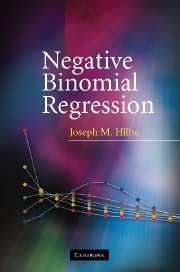Book contents
- Frontmatter
- Contents
- Preface
- Introduction
- 1 Overview of count response models
- 2 Methods of estimation
- 3 Poisson regression
- 4 Overdispersion
- 5 Negative binomial regression
- 6 Negative binomial regression: modeling
- 7 Alternative variance parameterizations
- 8 Problems with zero counts
- 9 Negative binomial with censoring, truncation, and sample selection
- 10 Negative binomial panel models
- Appendix A Negative binomial log-likelihood functions
- Appendix B Deviance functions
- Appendix C Stata negative binominal – ML algorithm
- Appendix D Negative binomial variance functions
- Appendix E Data sets
- References
- Author Index
- Subject Index
8 - Problems with zero counts
Published online by Cambridge University Press: 05 June 2012
- Frontmatter
- Contents
- Preface
- Introduction
- 1 Overview of count response models
- 2 Methods of estimation
- 3 Poisson regression
- 4 Overdispersion
- 5 Negative binomial regression
- 6 Negative binomial regression: modeling
- 7 Alternative variance parameterizations
- 8 Problems with zero counts
- 9 Negative binomial with censoring, truncation, and sample selection
- 10 Negative binomial panel models
- Appendix A Negative binomial log-likelihood functions
- Appendix B Deviance functions
- Appendix C Stata negative binominal – ML algorithm
- Appendix D Negative binomial variance functions
- Appendix E Data sets
- References
- Author Index
- Subject Index
Summary
I have indicated that extended negative binomial models are generally developed to solve either a distributional or variance problem arising in the base NB-2 model. Changes to the negative binomial variance function were considered in the last chapter. In this chapter, we address the difficulties that arise when there are either no possible zeros in the data, or when there are an excessive number.
Zero-truncated negative binomial
Often we are asked to model count data that structurally exclude zero counts. Hospital length of stay data are an excellent example of count data that cannot have a zero count. When a patient first enters the hospital, the count begins. Upon registration the length of stay is given as 1. There can be no 0 days – unless we are describing patients who do not enter the hospital, and this is a different model where there may be two generating processes. This type of model will be discussed later.
The Poisson and negative binomial distributions both include zeros. When data structurally exclude zero counts, then the underlying probability distribution must preclude this outcome to properly model the data. This is not to say that Poisson and negative binomial models are not commonly used to model such data, the point is that they should not. The Poisson and negative binomial probability functions, and their respective log-likelihood functions, need to be amended to exclude zeros, and at the same time provide for all probabilities in the distribution to sum to one.
- Type
- Chapter
- Information
- Negative Binomial Regression , pp. 160 - 178Publisher: Cambridge University PressPrint publication year: 2007

